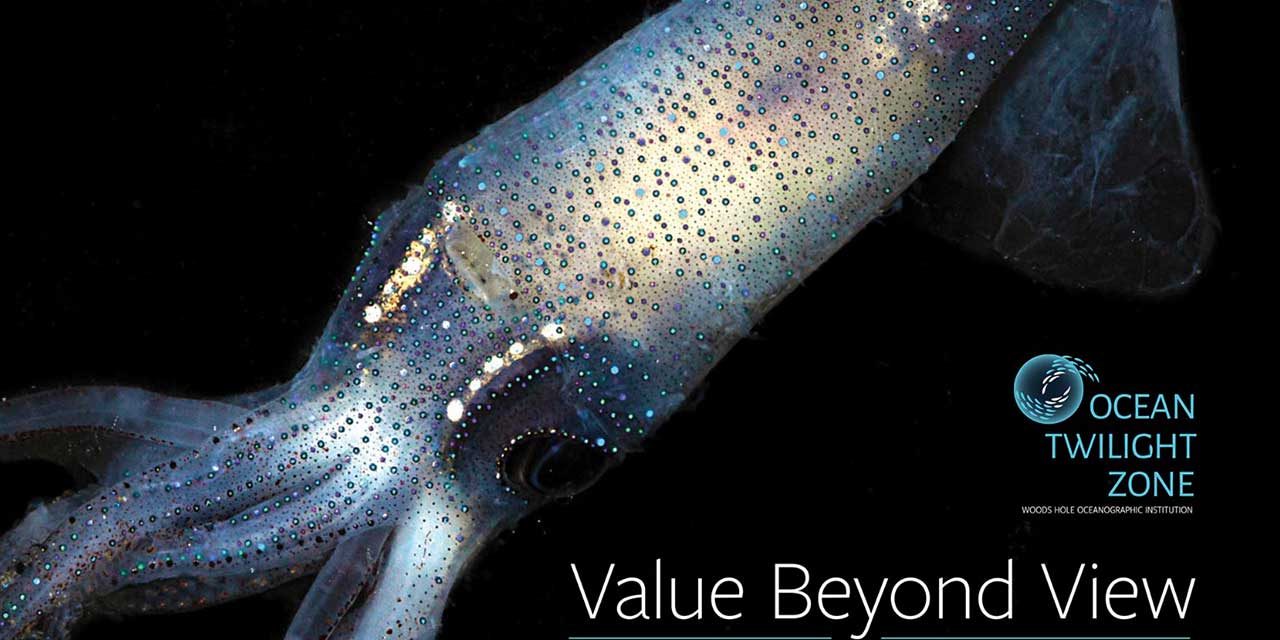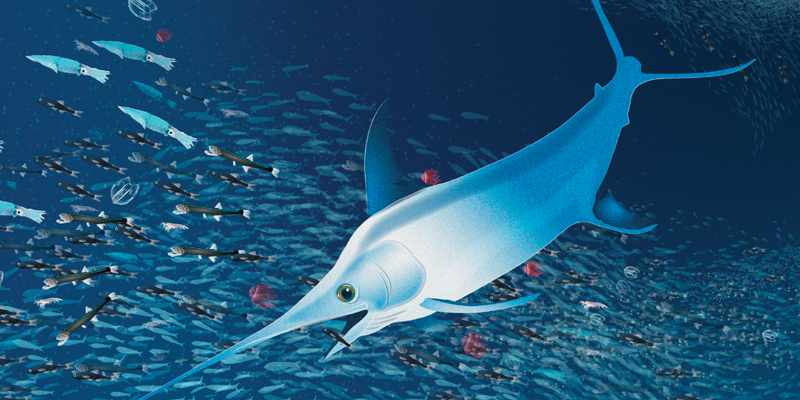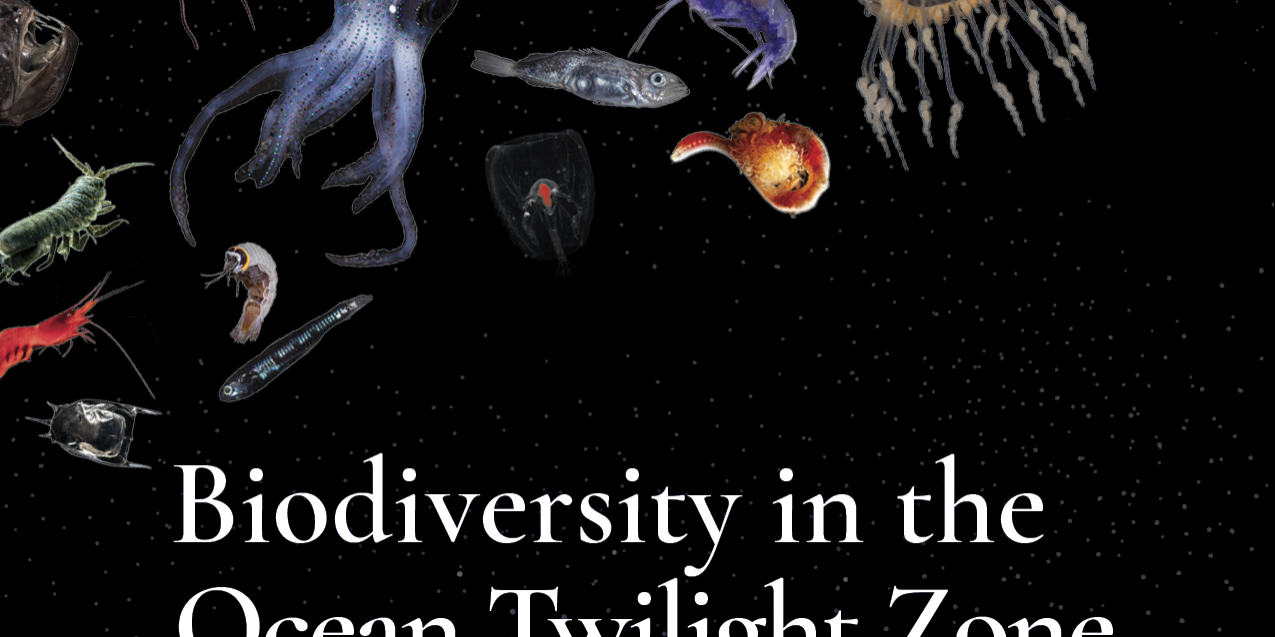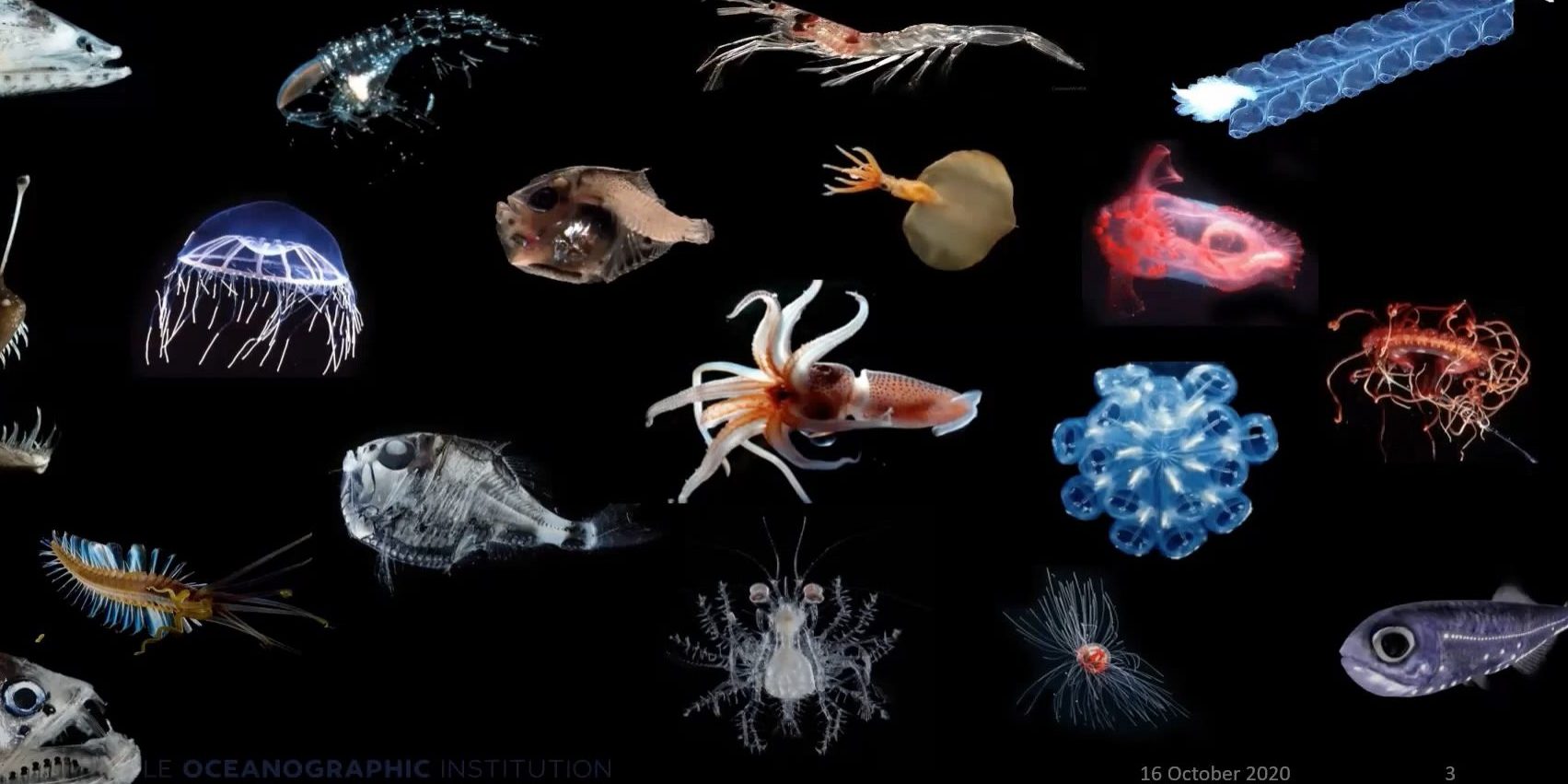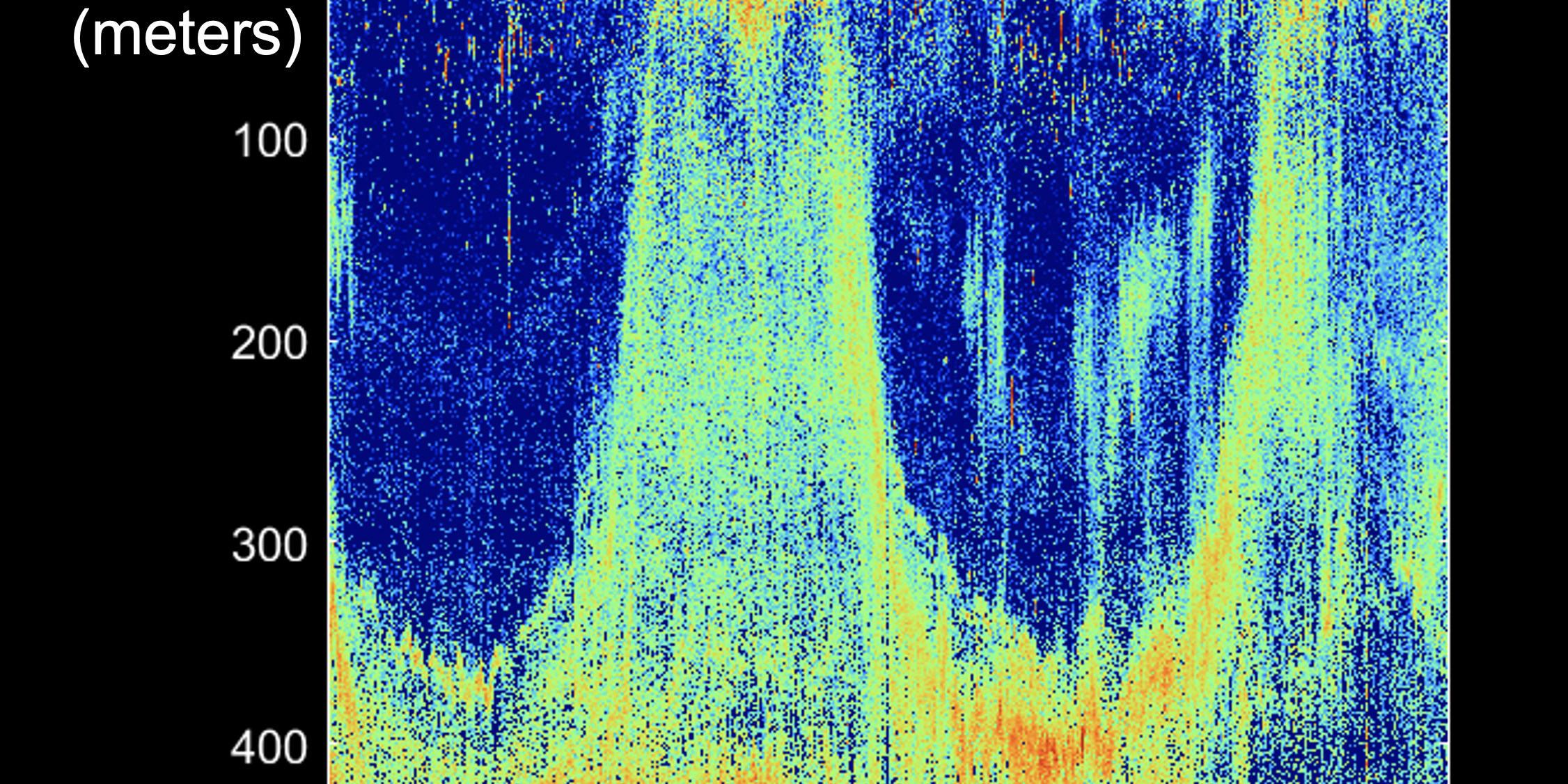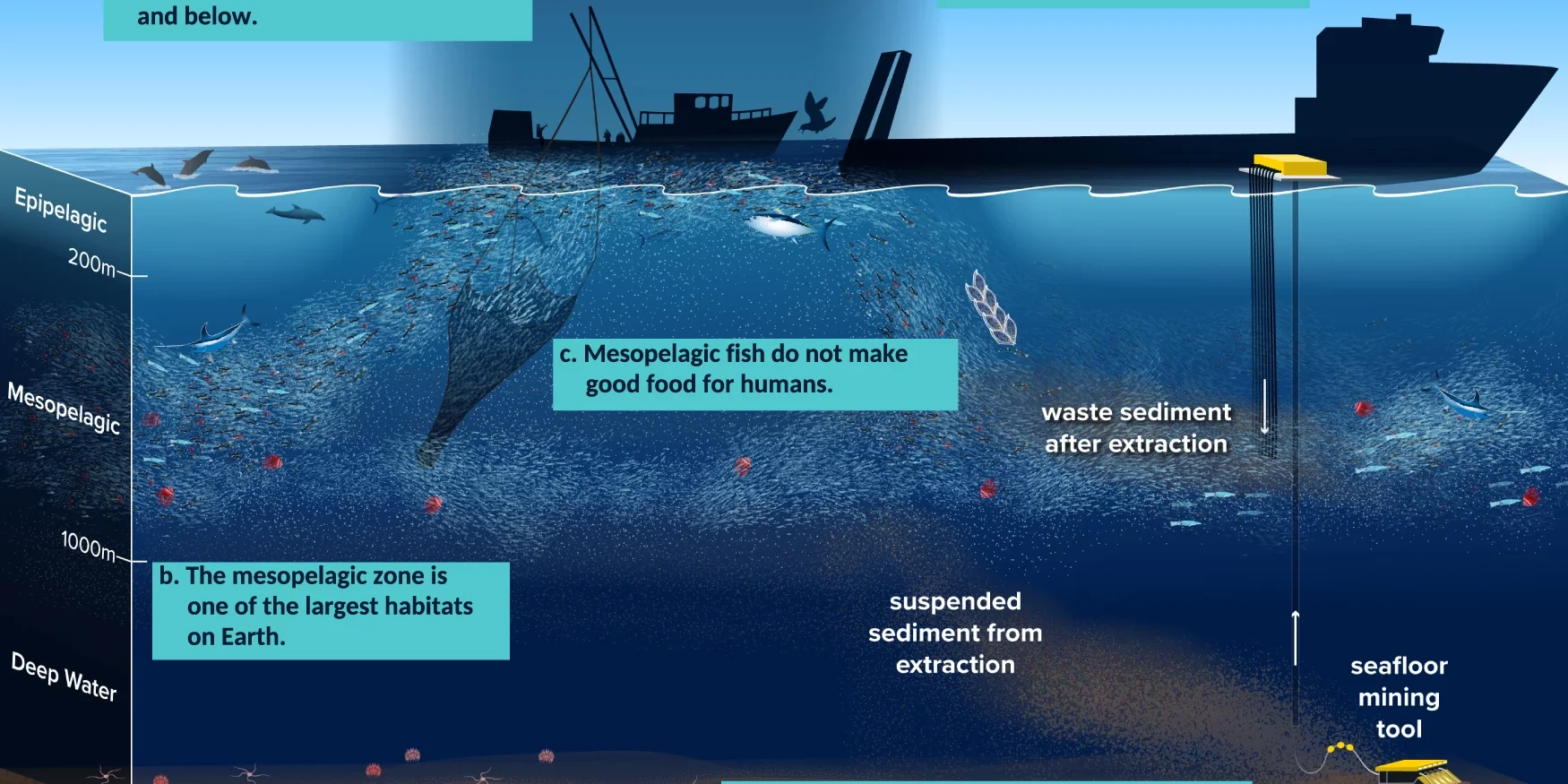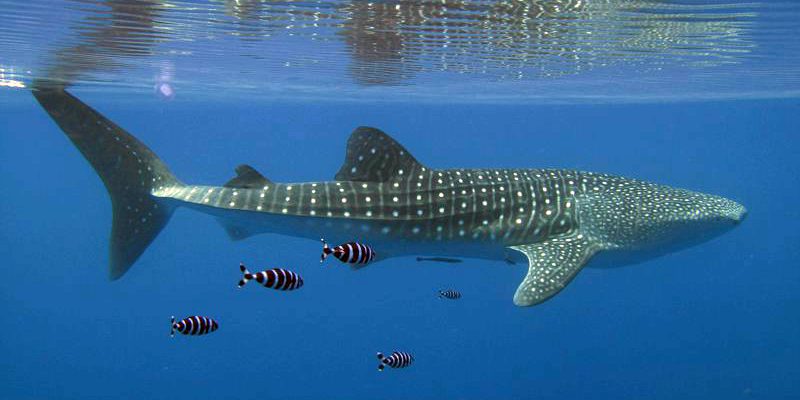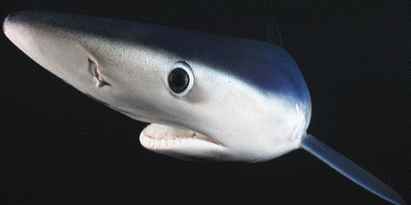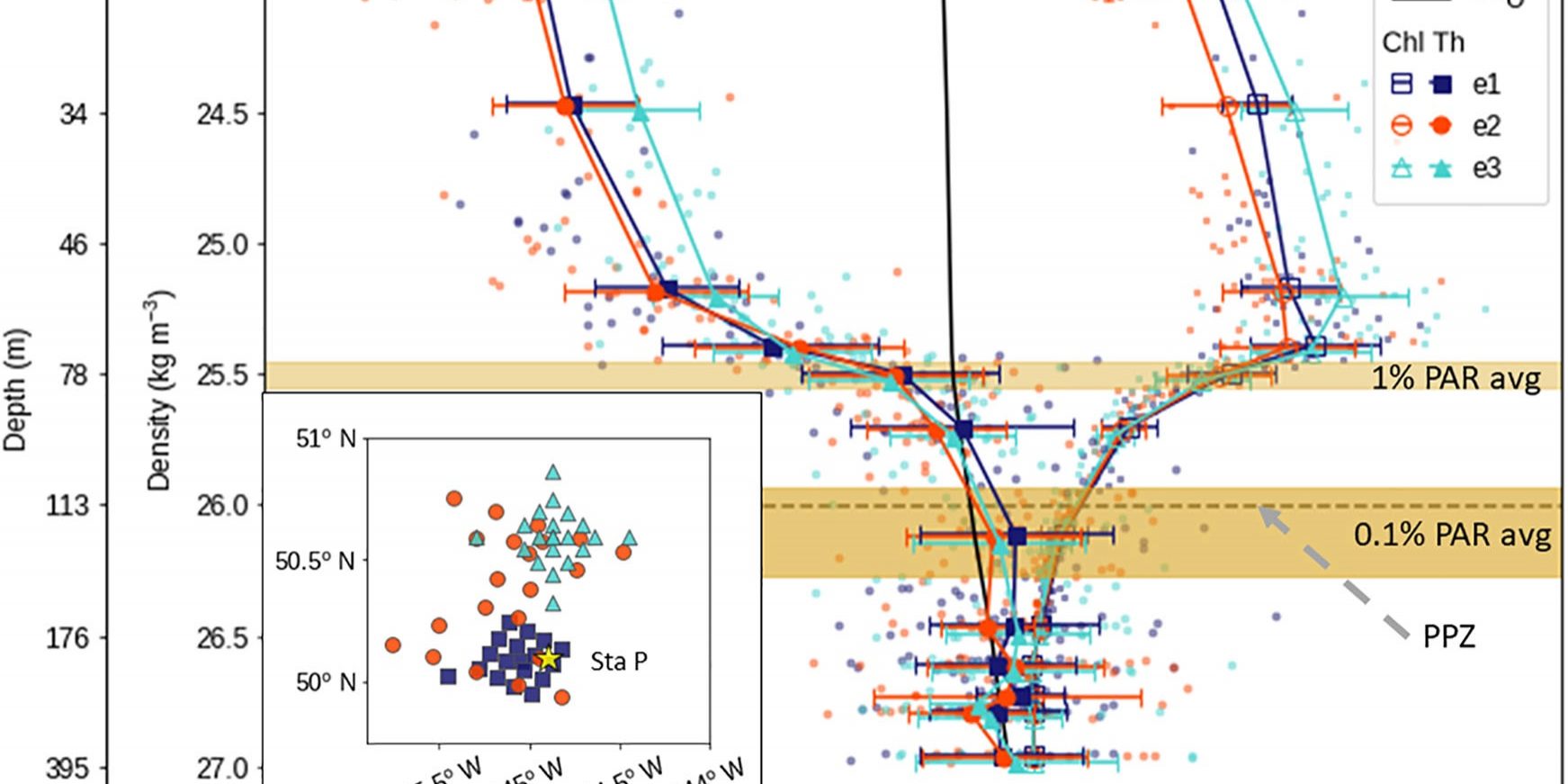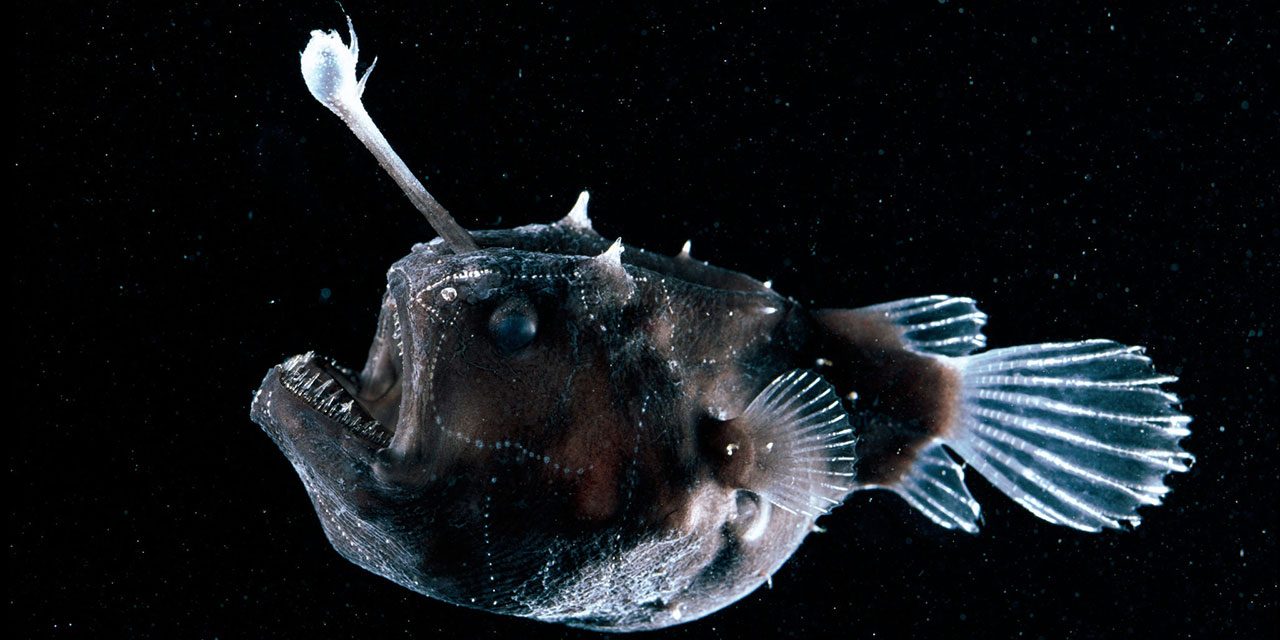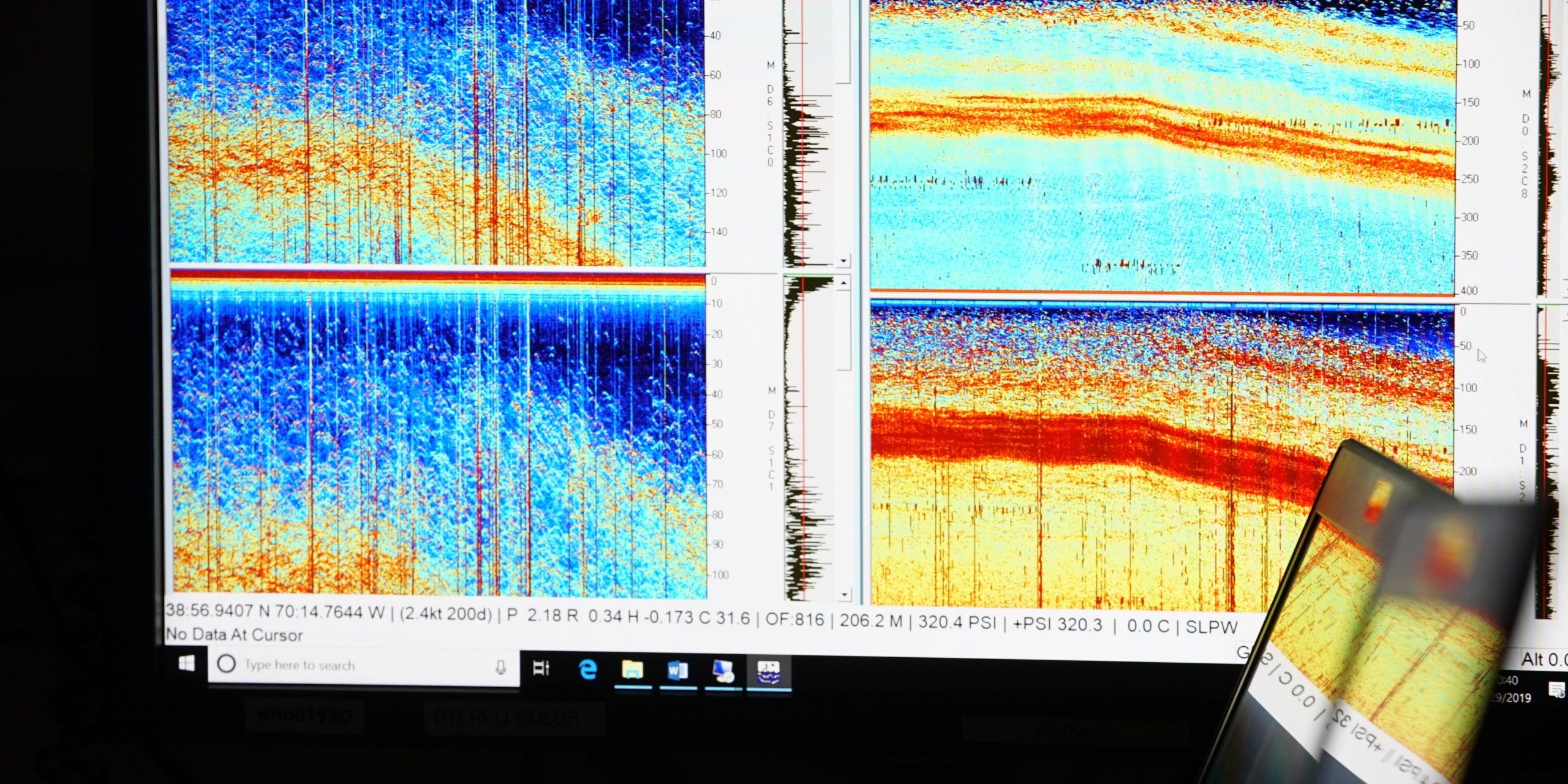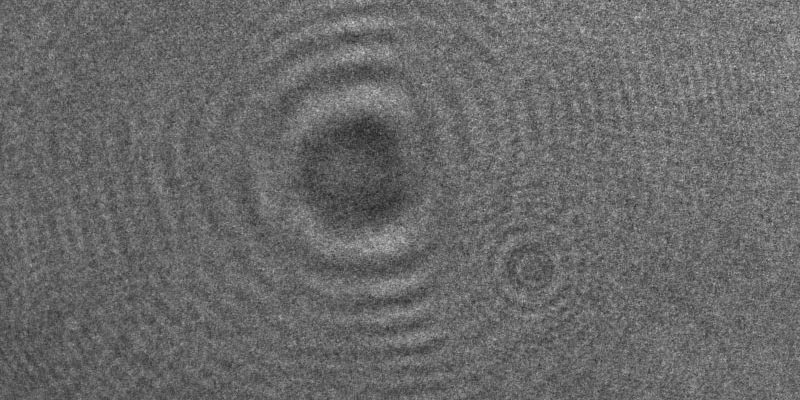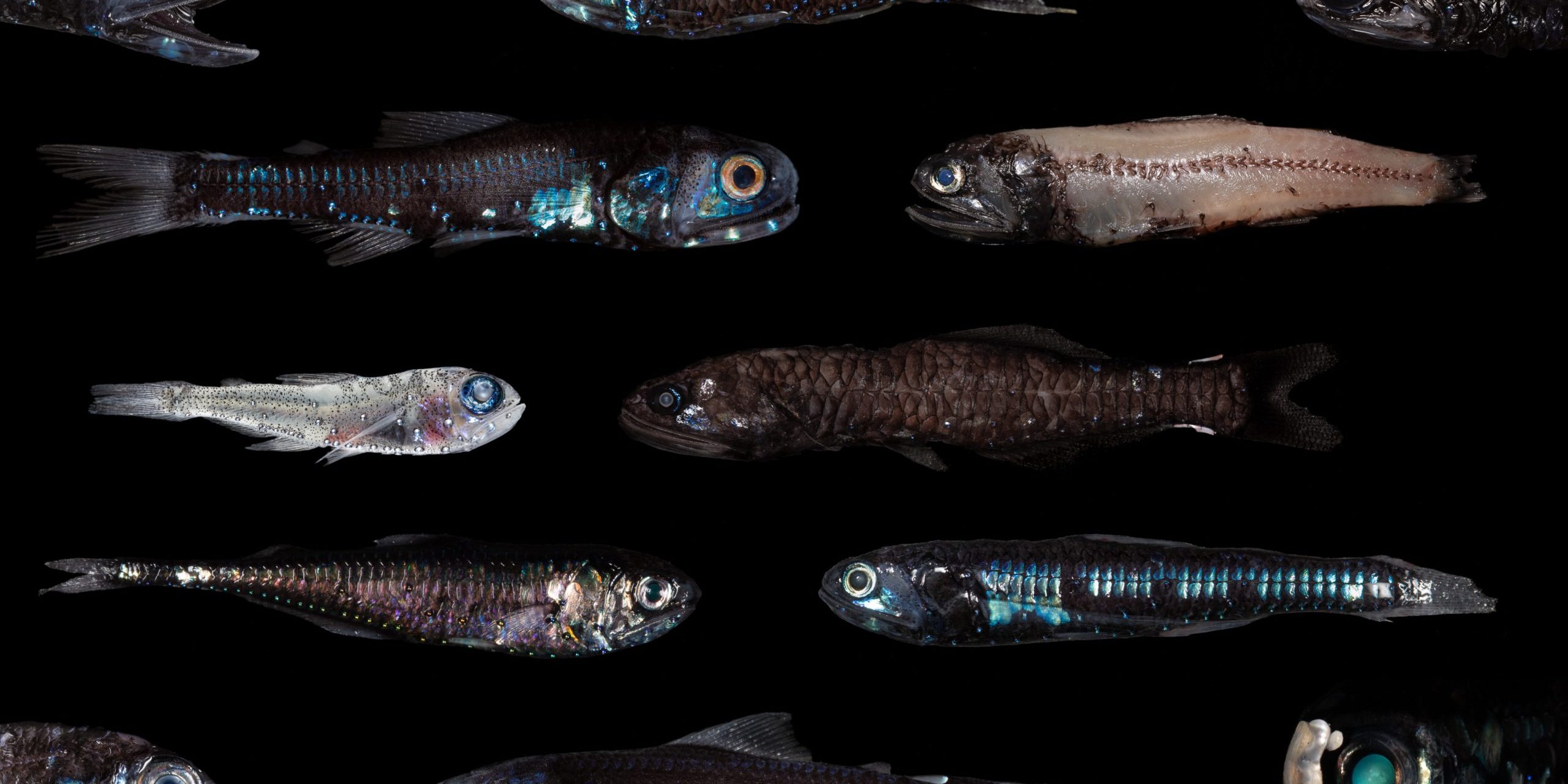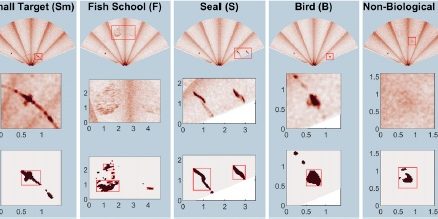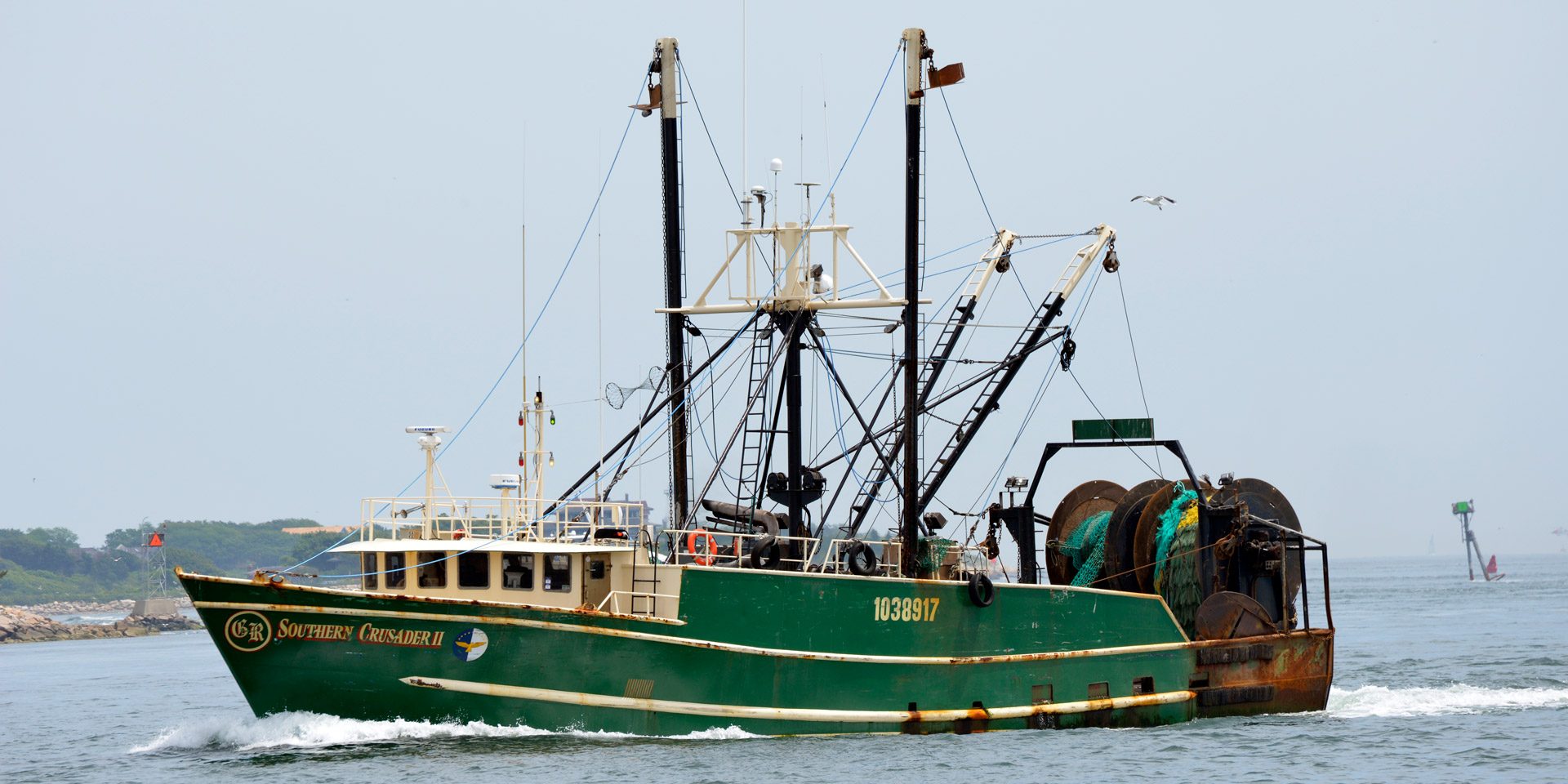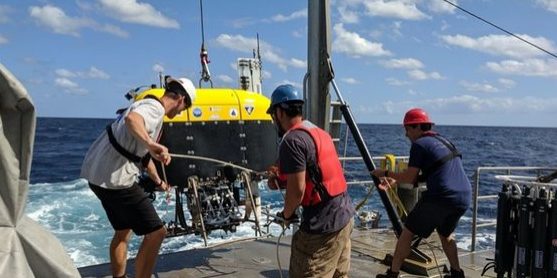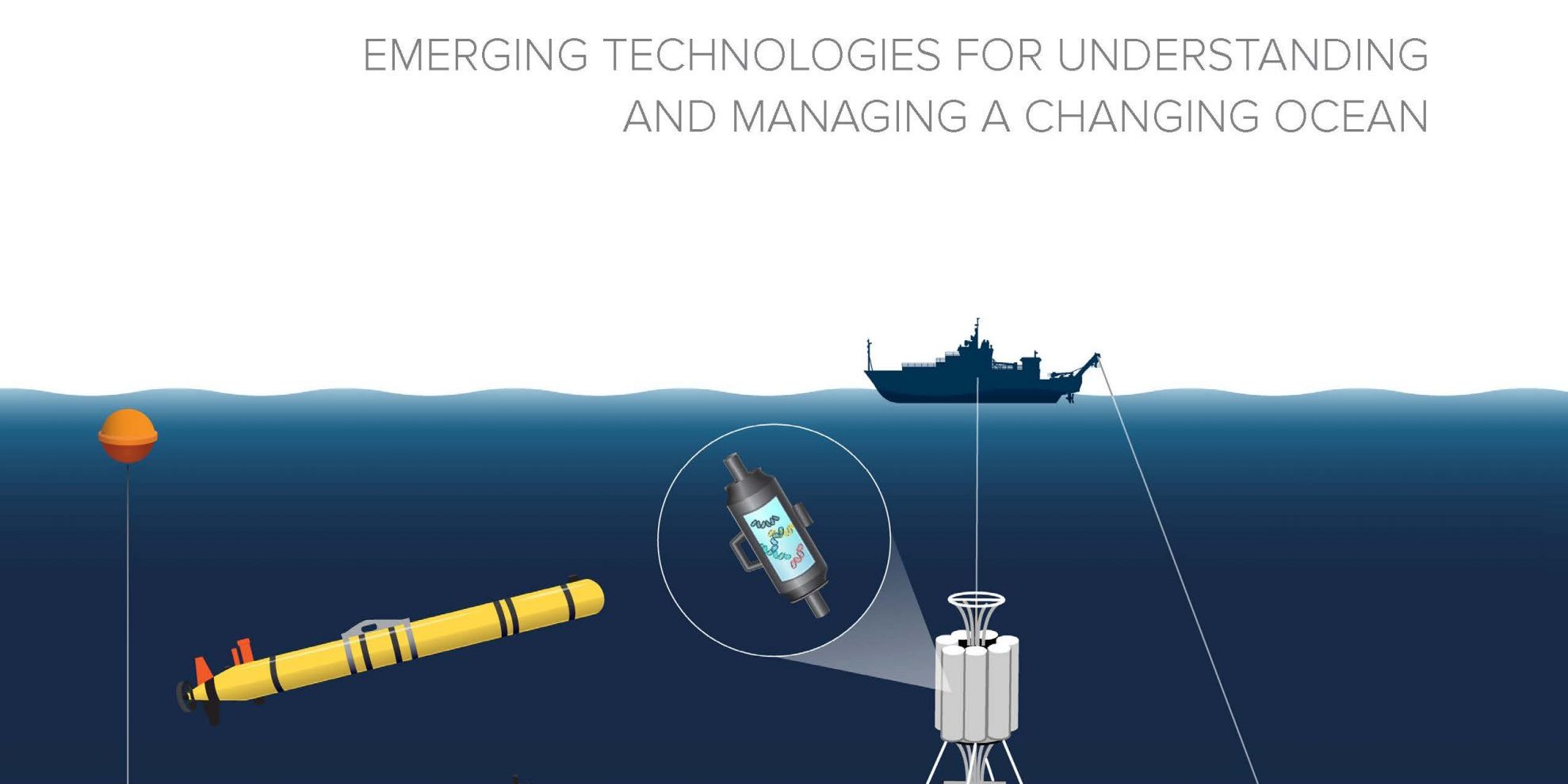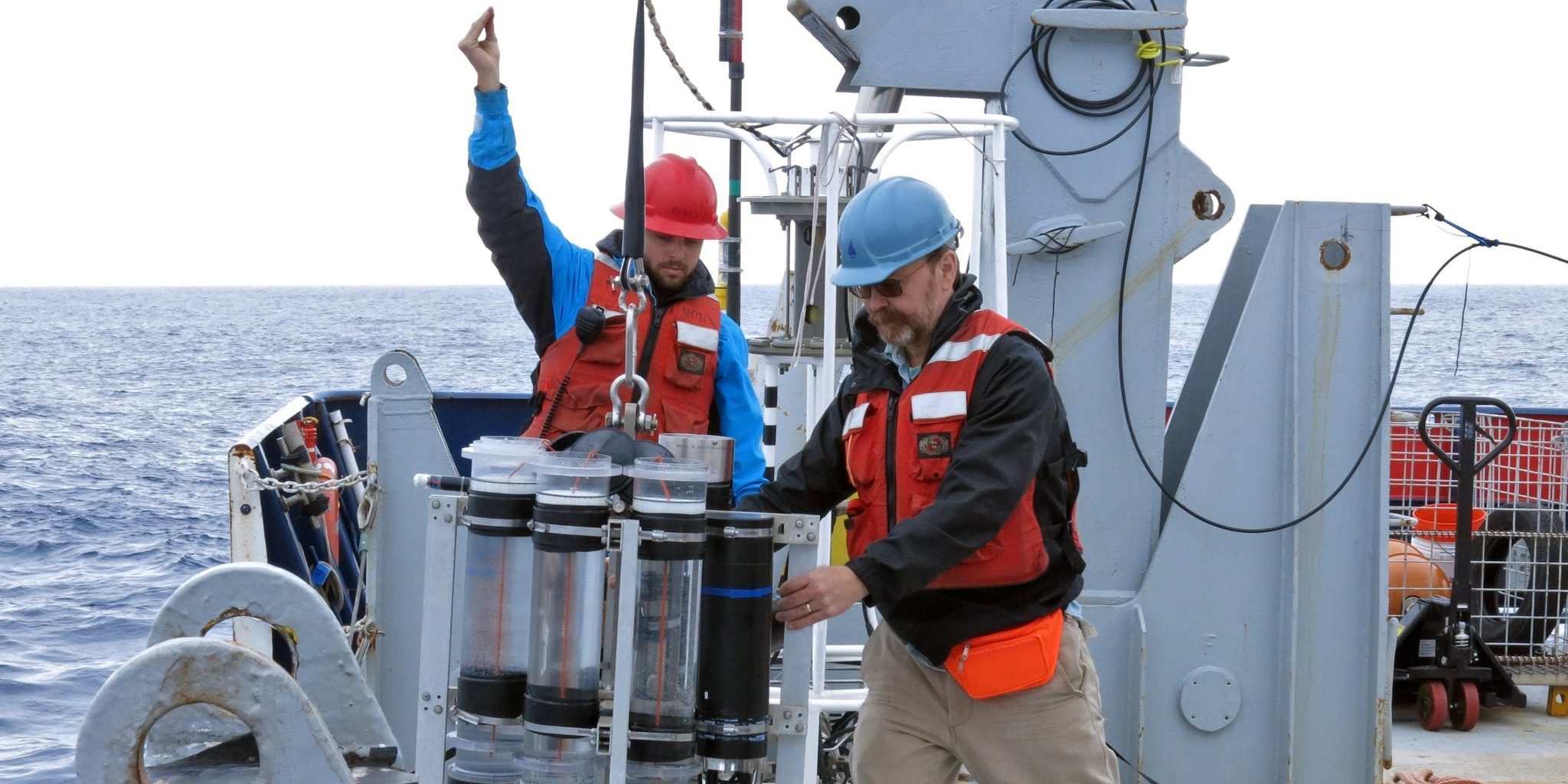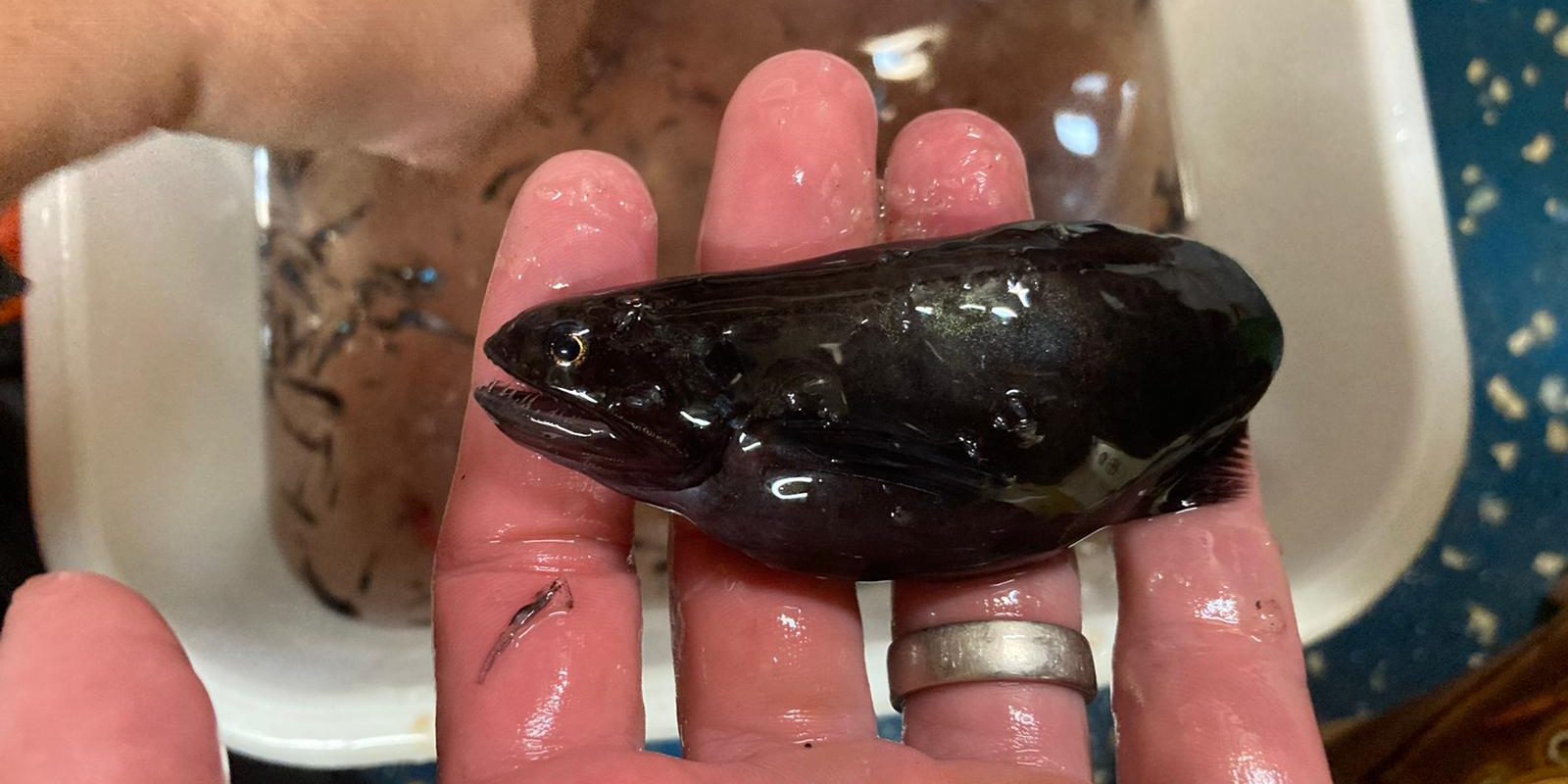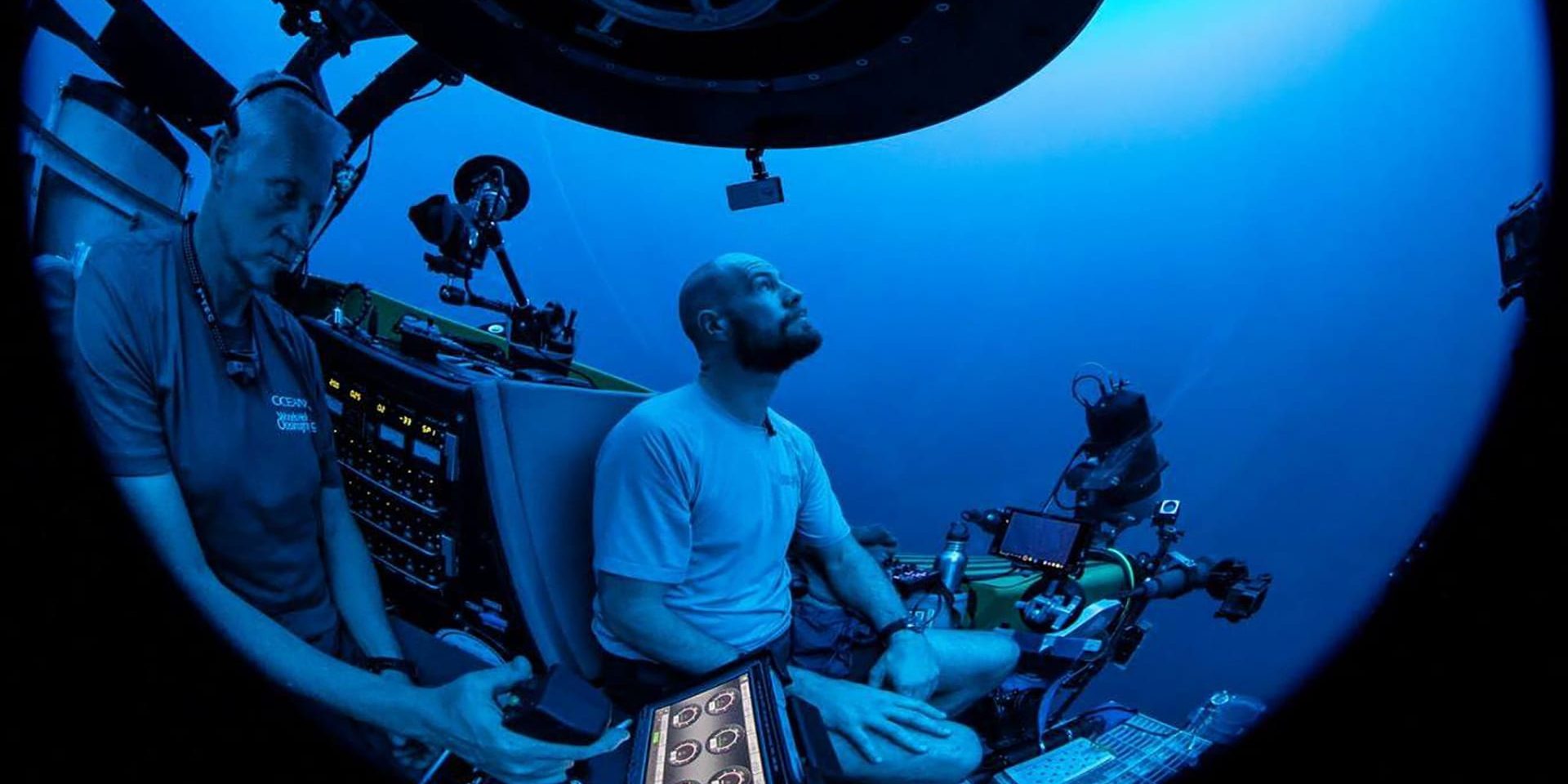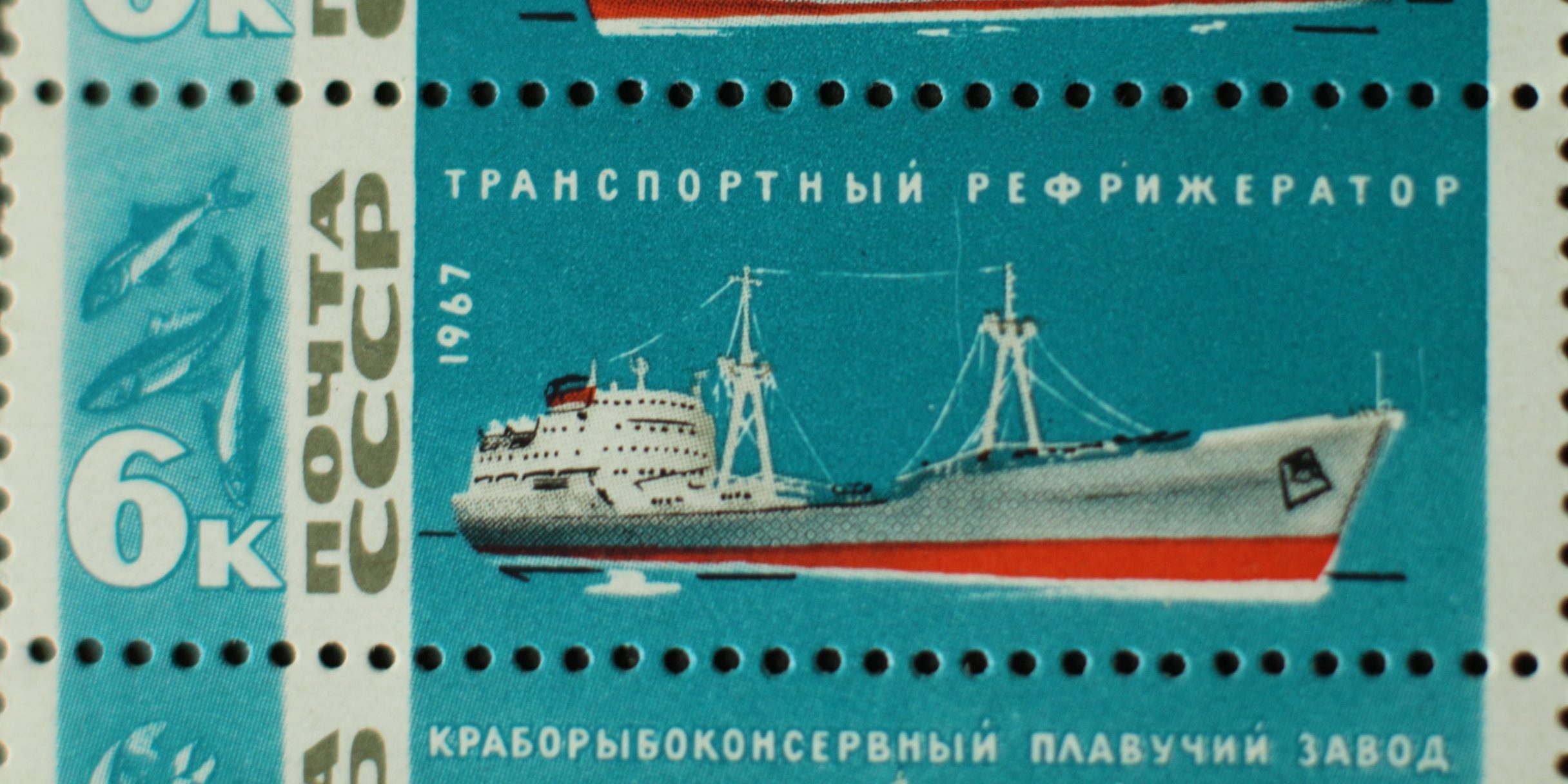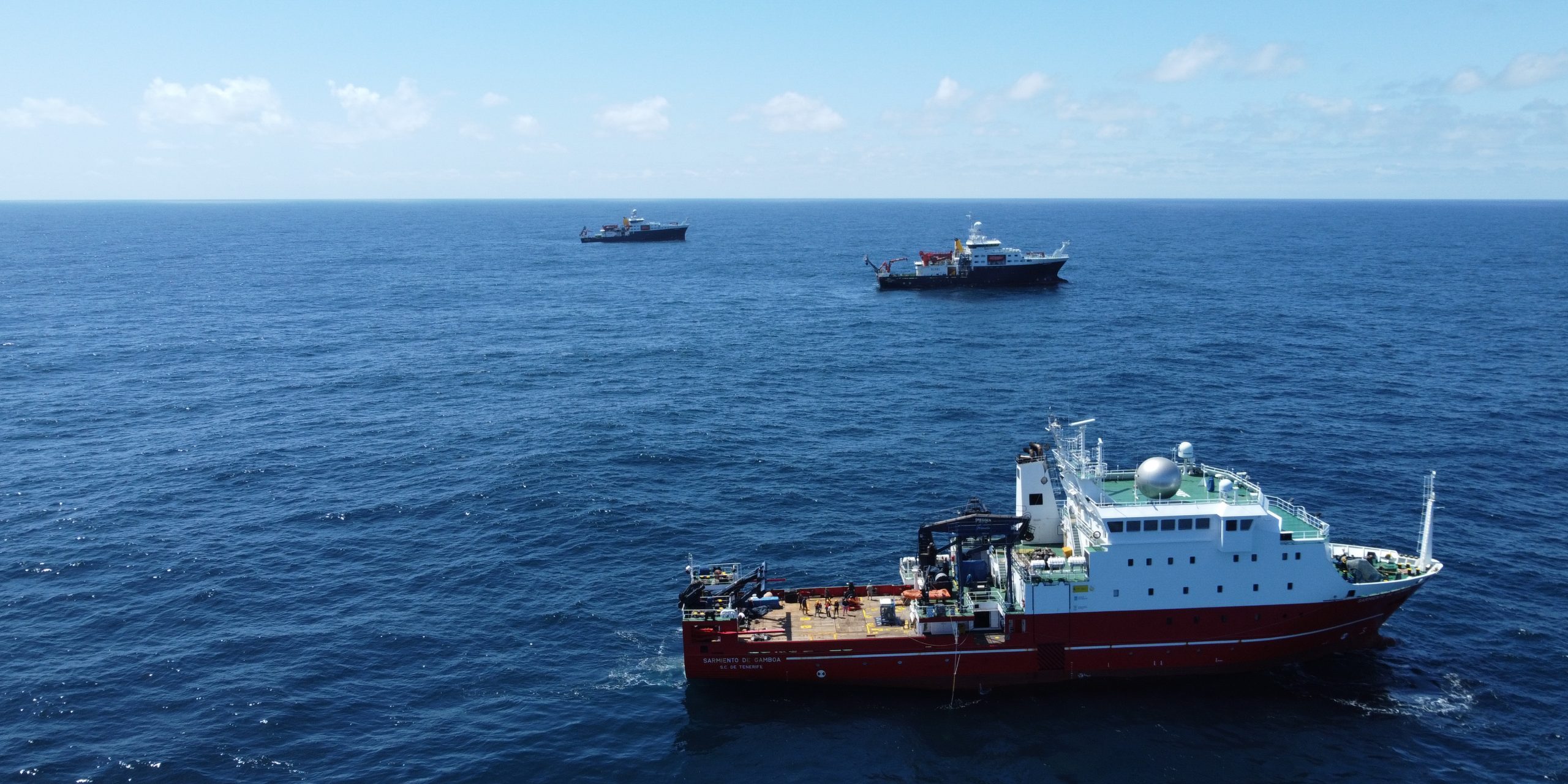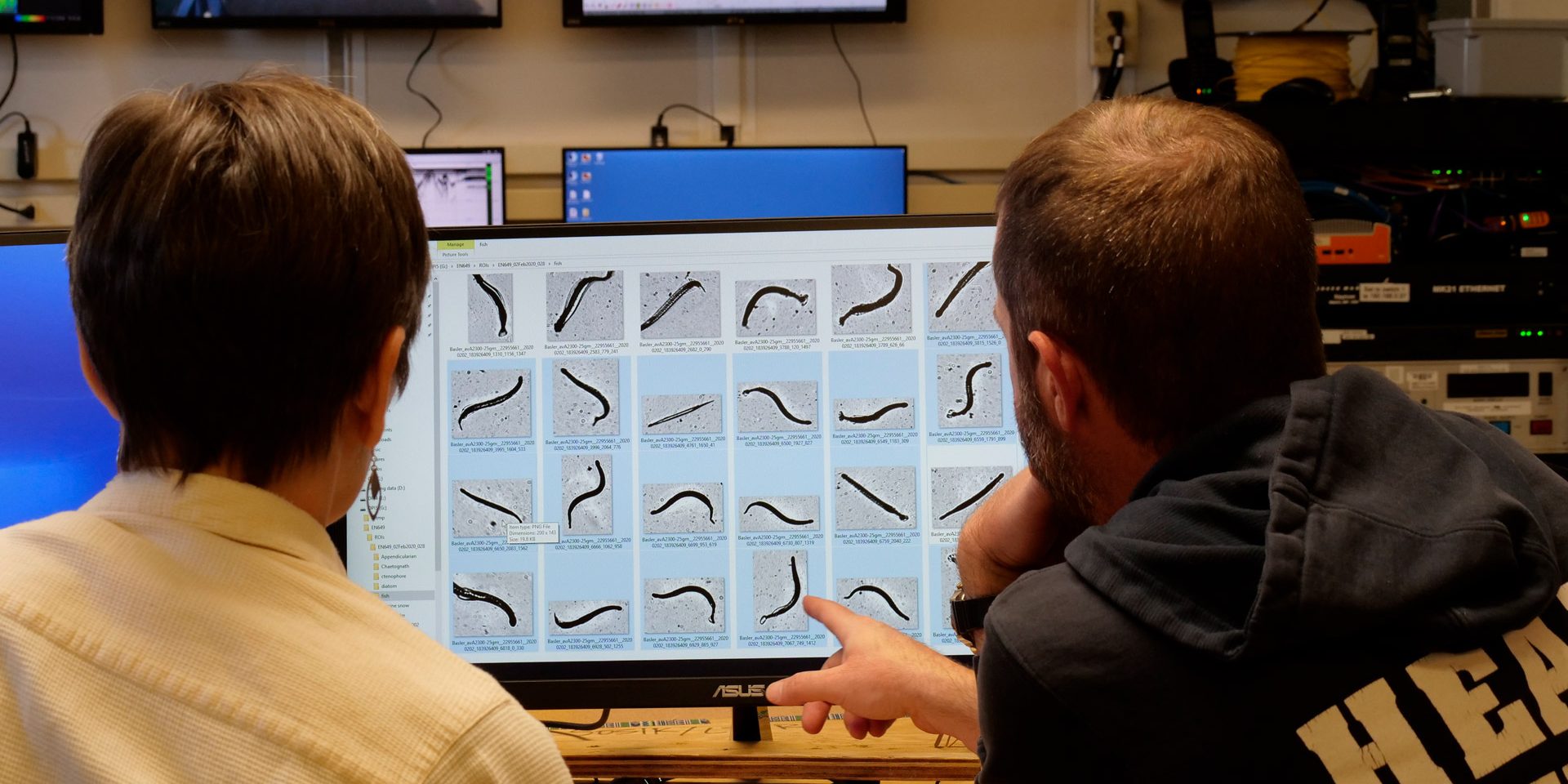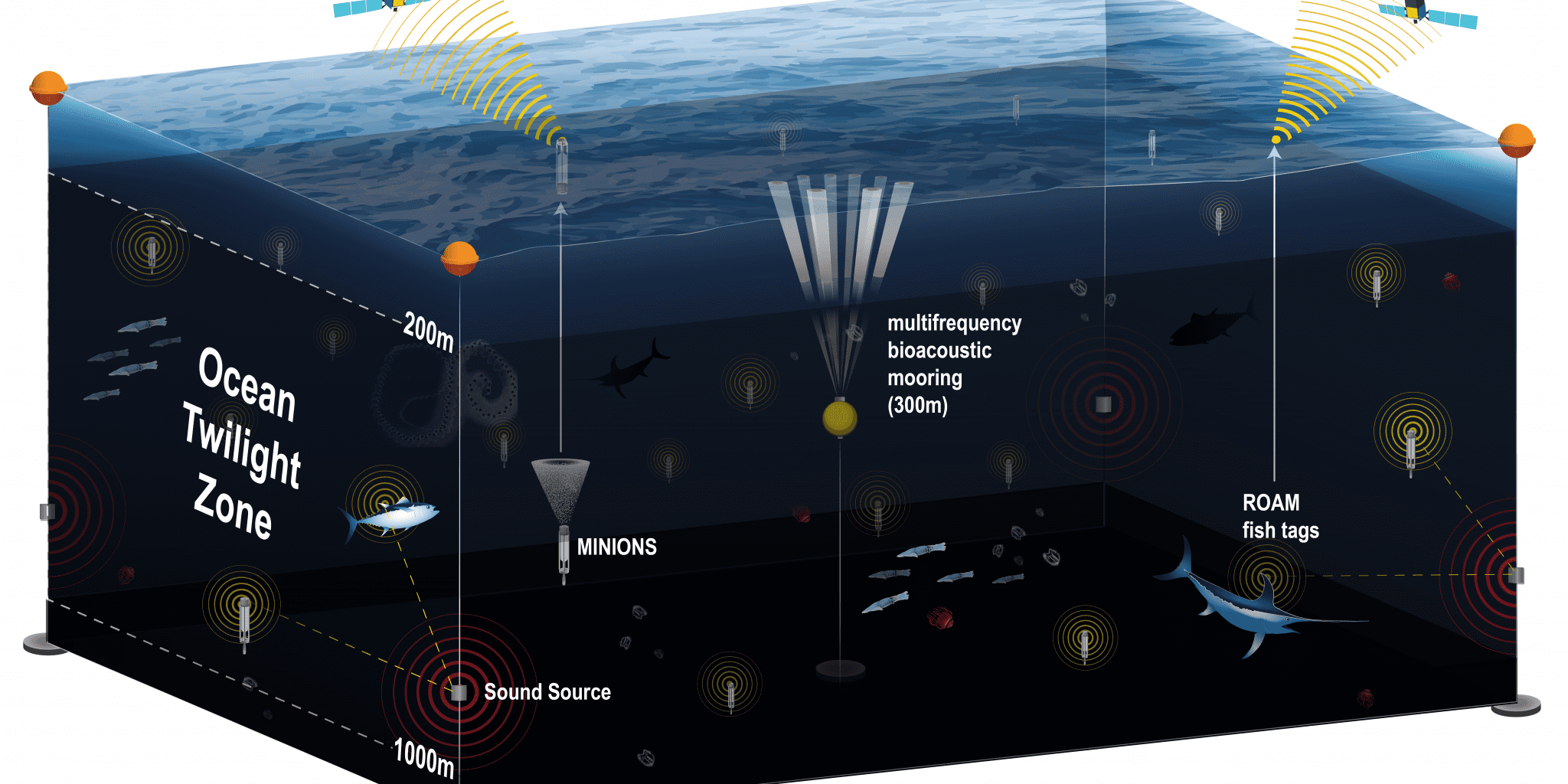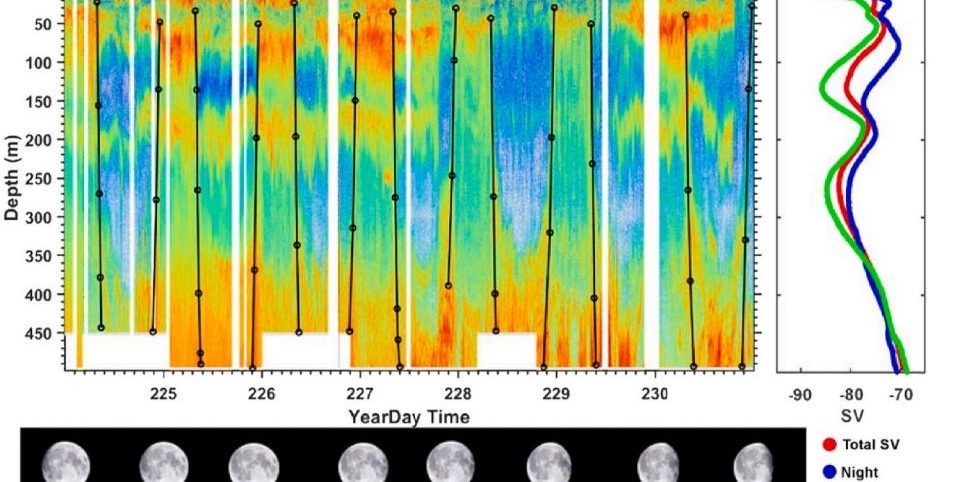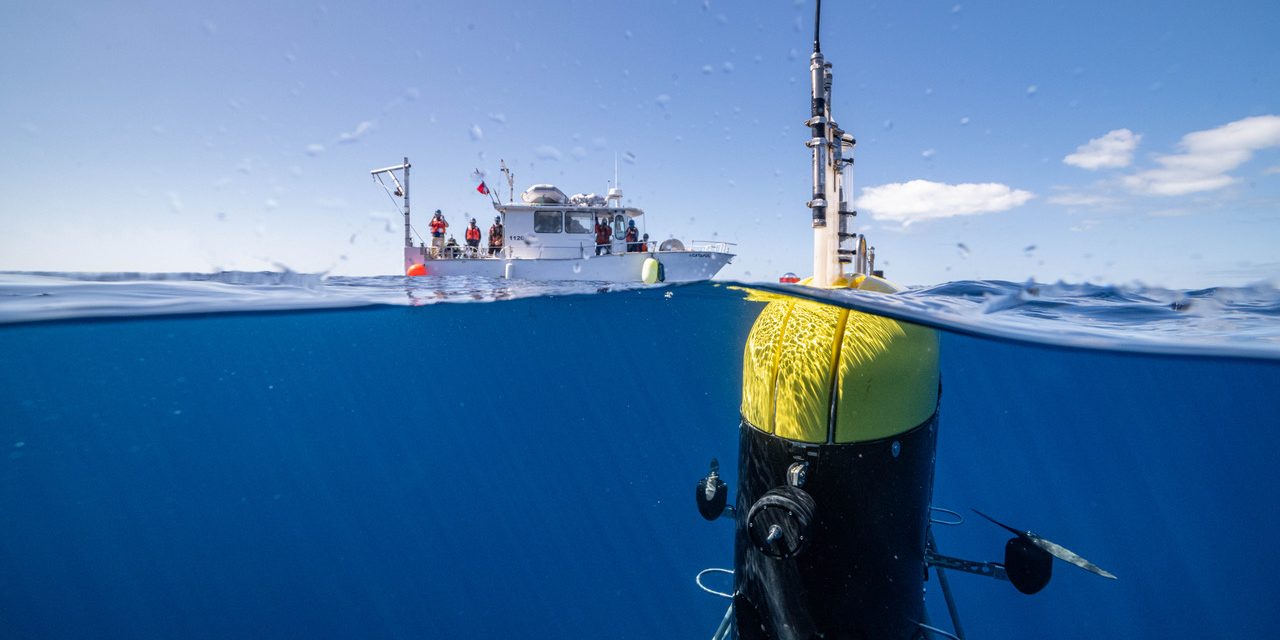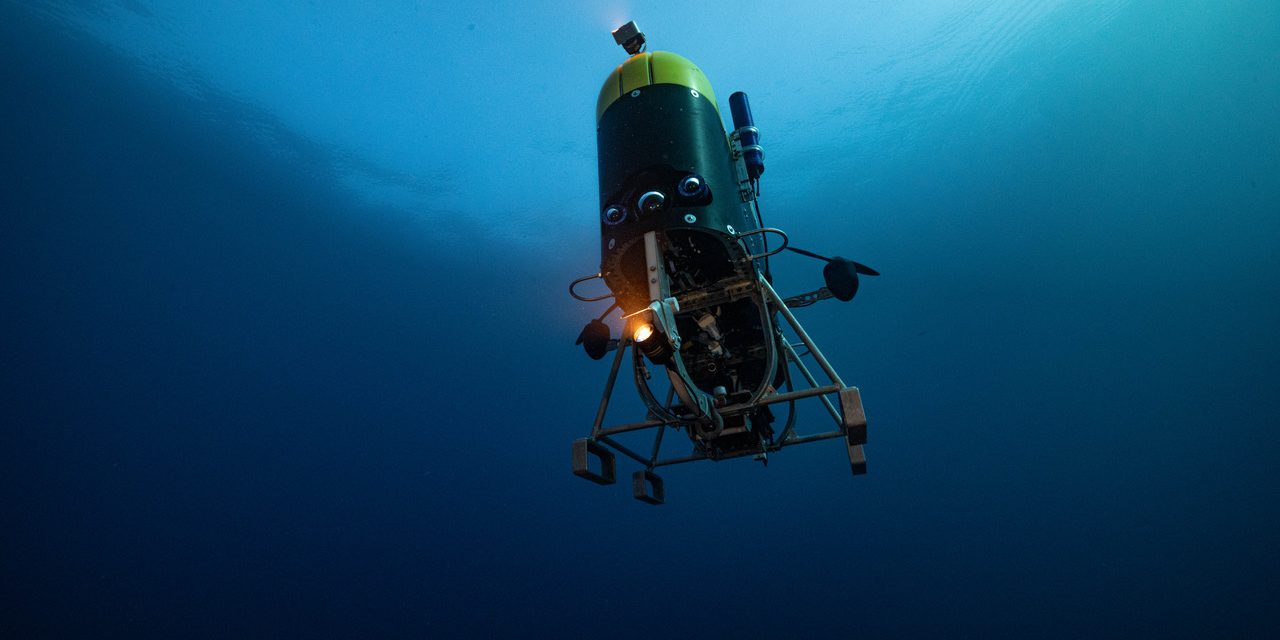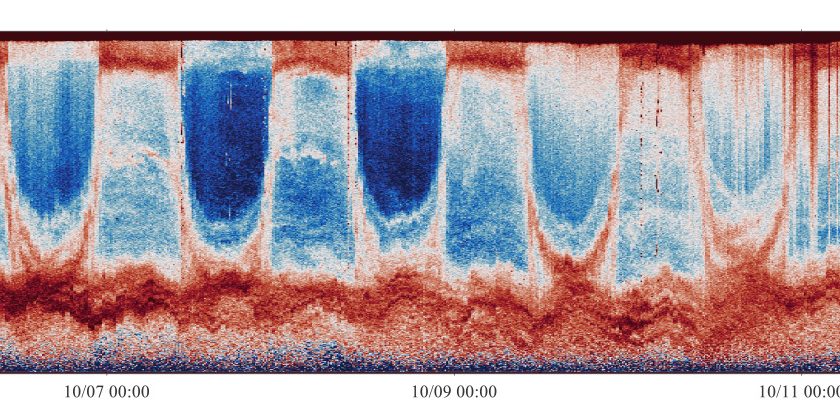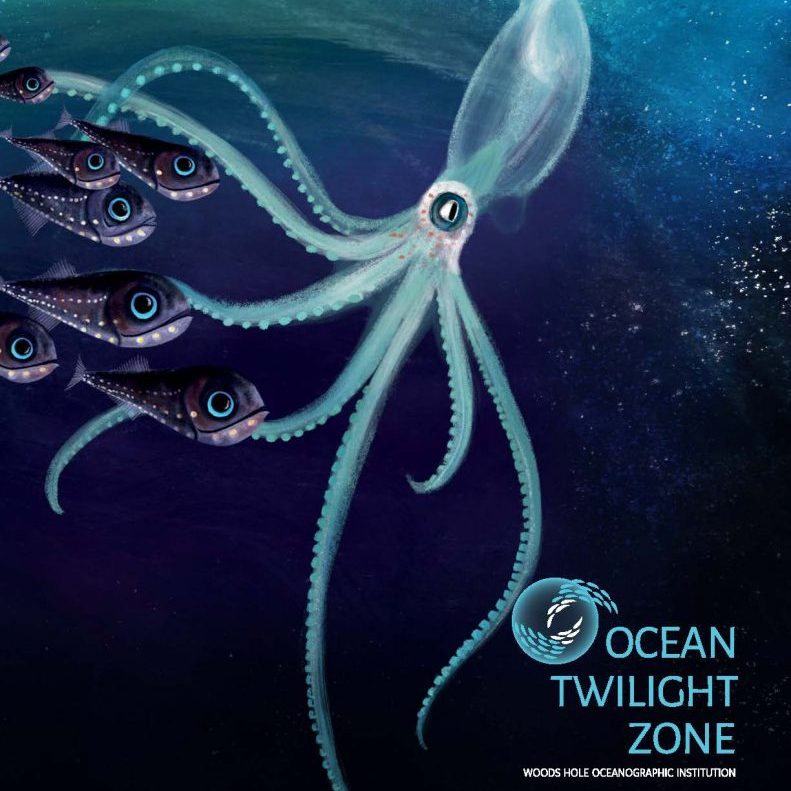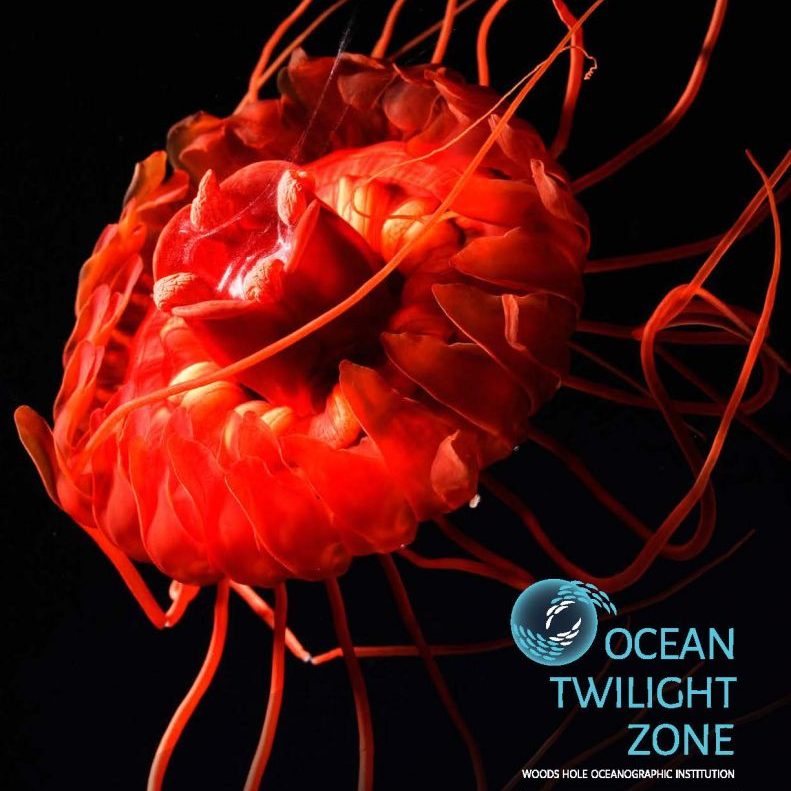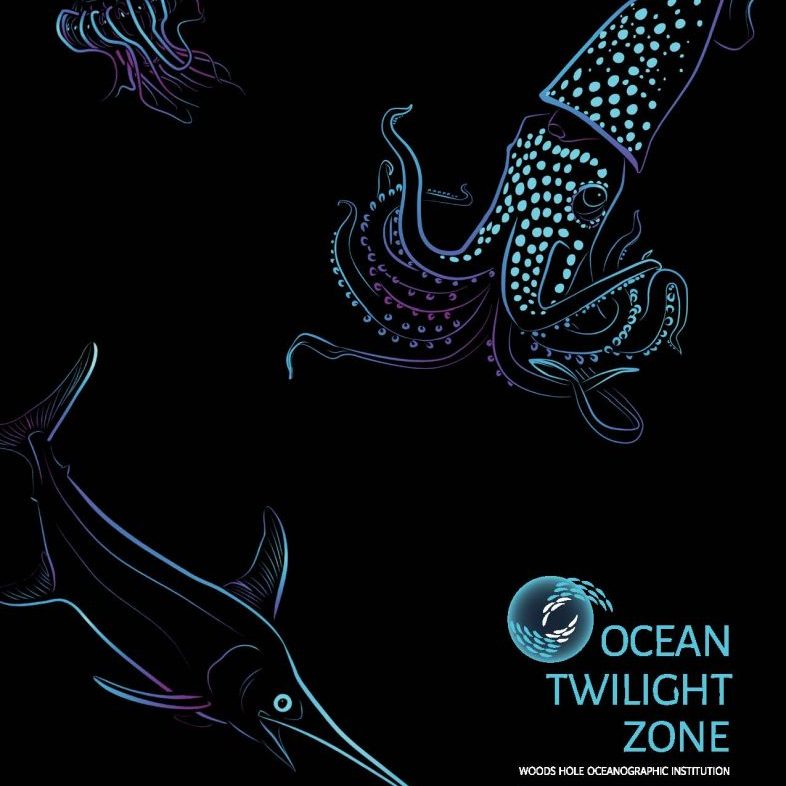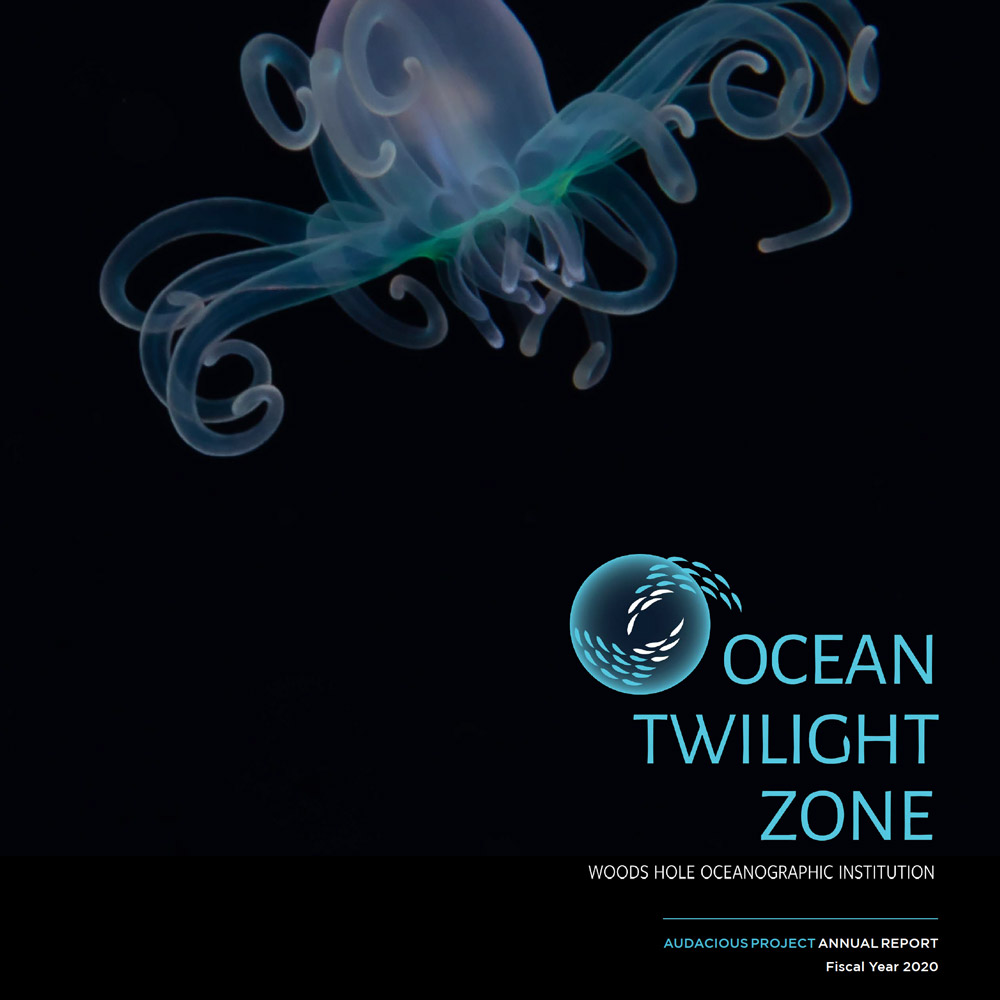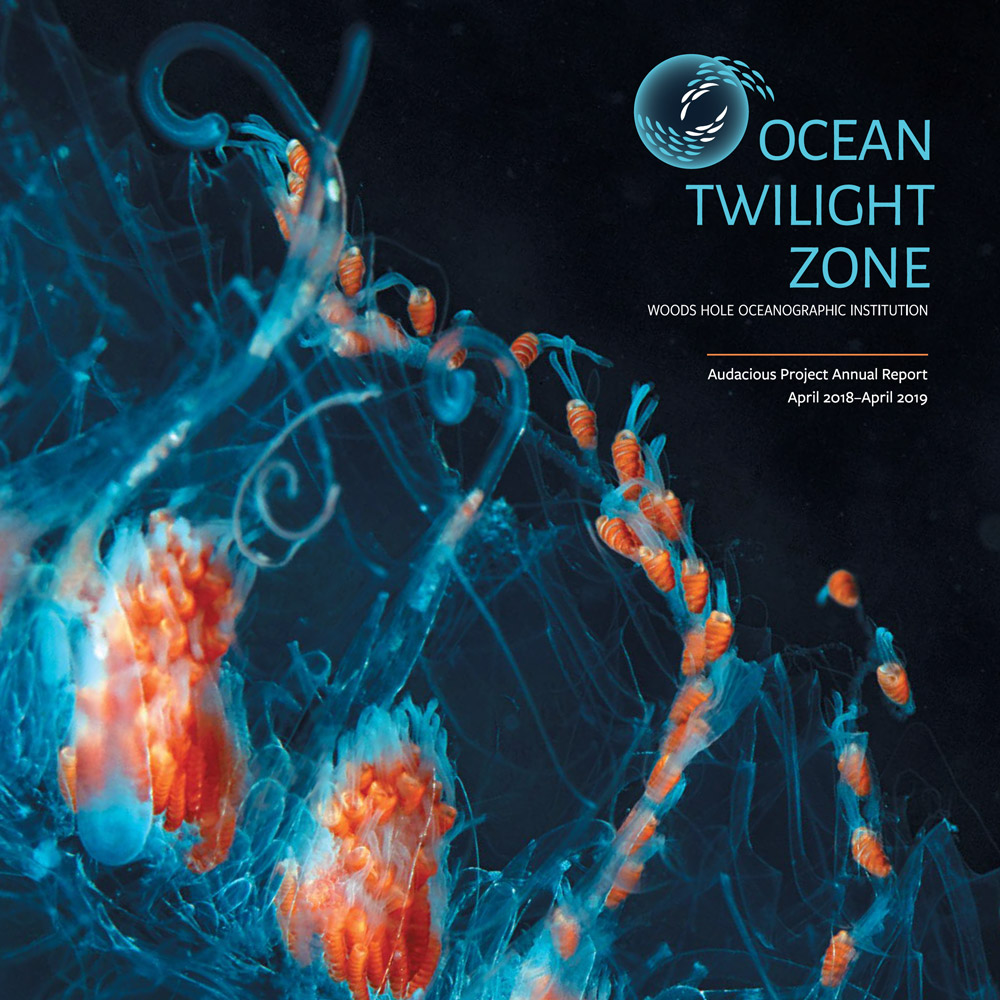Ocean Twilight Zone Publications and Reports
Final Report
Ocean Twilight Zone Project Final Donor Report
Woods Hole Oceanographic Institution (WHOI) has spent the last six years exploring one of our planet’s last frontiers: the ocean twilight zone. Our scientists, engineers, and communications professionals have worked together to build new technologies, gather first-of-their-kind datasets, advance scientific understanding, and raise awareness of this critical region of the ocean in ways that ensure our science has the greatest possible impact.
Policy Reports
Value Beyond View: Illuminating the Human Benefits of the Ocean Twilight Zone
Hoagland, Porter; Jin, Di; Holland, Michael; Kostel, Ken; Taylor, Eric; Renier, Natalie; Holmes, Mark. Published January 2019.
The Ocean Twilight Zone's Role in Climate
Ken Buesseler, Di Jin, Melina Kourantidou, David Levin, Kilaparti Ramakrishna, Philip Renaud. Published February 2021.
Biodiversity in the Ocean Twilight Zone
Yang, Nina; Annette Govindarajan Di Jin. Published April, 2024
Academic Publications
Environmental DNA shedding and decay rates from diverse animal forms and thermal regimes
Allan, Elizabeth Andruszkiewicz Weifeng Gordon Zhang, Andone Lavery, Annette Govindarajan. Published September, 2020 in Environmental DNA.
Environmental DNA shedding and decay rates from diverse animal forms and thermal regimes
Allan, Elizabeth A.. Michelle H. DiBenedetto, Andone C. Lavery, Annette F. Govindarajan & Weifeng G. Zhang. Published October, 2021 in Environmental DNA.
Frequency- and depth- dependent target strength measurements of individual mesopelagic scatterers
Christopher Bassett, Andone C. Lavery, Timothy K. Stanton, and Emma DeWitt Cotter. Published August, 2020 in The Journal of the Acoustical Society of America.
Five reasons to take the precautionary approach to deep sea exploitation
Bisson, Kelsey; Helena McMonagle, Ilysa Iglesias, Svenja Halfter & Natalya Gallo. Published May 2023 in Nature Communications Earth & Environment.
The Functional and Ecological Significance of Deep Diving by Large Marine Predators
Braun, Camrin; Martin Arostegui, Simon Thorrold, Yannis Papastamatiou, Peter Gaube, Jorge Fontes, and Pedro Afonso. Published August 2021 in the Annual Review of Marine Science
Mesoscale eddies release pelagic sharks from thermal constraints to foraging in the ocean twilight zone
Braun, Camrin; Peter Gaube, Tane H. Sinclair-Taylor, Gregory B. Skomal, and Simon R. Thorrold. Published August 2019 in PNAS.
High resolution spatial and temporal measurements of particulate organic carbon flux using thorium-234 in the northeast Pacific Ocean during the EXPORTS field campaign.
Buesseler, K.O., Benitez-Nelson, C.R., Roca-Marti, M., Wyatt, A.M., Resplandy, L., Clevenger, S.J., Drysdale, J.A., Estapa, M.L., Pike, S., Umhau, B.P. Published December 2020 in Elementa: Science of the Anthropocene.
Metrics that matter for assessing the ocean biological carbon pump
Buesseler, Ken; Philip W. Boyd, Erin E. Black, and David A. Siegel. Published May 2020 in PNAS.
Review of the analysis of 234Th in small volume (2 - 4 L) seawater samples: improvements and recommendations.
Clevenger, S., Benitez-Nelson, C., Drysdale, J., Pike, S., Puigcorbe, V., Buesseler, K. Published June 2021 in the Journal of Radioanalytical and Nuclear Chemistry.
Comparison of mesopelagic organism abundance estimates using in situ target strength measurements and echo-counting techniques
Emma Cotter, Christopher Bassett, and Andone Lavery. Published April 2021 in JASA Express Letters.
Computationally efficient processing of in situ underwater digital holograms
Emma Cotter, Erin Fischell, Andone Lavery. Published June 2021 in Limnology and Oceanography.
Classification of broadband target spectra in the mesopelagic using physics-informed machine learning
Cotter, Emma; Christopher Bassett, and Andone Lavery. Published June 2021 in The Journal of the Acoustical Society of America.
Automatic Classification of Biological Targets in a Tidal Channel Using a Multibeam Sonar
Cotter, Emma and Brian Polagye. Published August 2020 in the Journal of Atmospheric and Oceanic Technology.
The economic tradeoffs and ecological impacts associated with a potential mesopelagic fishery in the California Current
Dowd, Sally; Melissa Chapman, Laura E. Koehn, Porter Hoagland. Published February 2022 in Ecological Applications.
Biogenic sinking particle fluxes and sediment trap collection efficiency at Ocean Station Papa
Estapa, M., Buesseler, K., Durkin, C.A., Omand, M., Benitez-Nelson, C.R., Roca-Marti, M., Breves, E., Kelly R.P., Pike, S. Published June 2021 in Elementa: Science of the Anthropocene.
Exploring the use of environmental DNA (eDNA) to detect animal taxa in the mesopelagic zone
Govindarajan, Annette; Rene D. Francolini, J. Michael Jech, Andone C. Lavery, Joel K. Llopiz, Peter H. Wiebe, and Weifeng (Gordon) Zhang. Published March 2021 in Frontiers in Ecology and Evolution.
Improved biodiversity detection using a large-volume environmental DNA sampler with in situ filtration and implications for marine eDNA sampling strategies
Govindarajan, Annette; Luke McCartin, Allan Adams, Elizabeth Allan, Abhimanyu Belani, Rene Francolinia, Justin Fujii, Daniel Gomez-Ibañeze, Amy Kukulya, Fredrick Marin, Kaitlyn Tradd, Dana R. Yoerger, Jill M.McDermott, Santiago Herrera. Published September 2022 in Deep Sea Resaerch.
Advances in Environmental DNA Sampling for Observing Ocean Twilight Zone Animal Diversity
Annette F. Govindarajan, Allan Adams, Elizabeth Allan, Santiago Herrera, Andone Lavery, Joel Llopiz, Luke McCartin, Dana R. Yoerger, and Weifeng Zhang. Published January 2023 in Oceanography.
The value of scientific research on the ocean's biological carbon pump
Jin, Di; Porter Hoagland, and Ken Buesseler. Published December 2020 in Science of The Total Environment.
Broadband scattering from mesopelagic jellyfish
Rachel E. Kahn and Andone C. Lavery. Published October 2020 in The Journal of the Acoustical Society of America.
Mesopelagic–epipelagic fish nexus in viability and feasibility of commercial‐scale mesopelagic fisheries
Kourantidou, Melina and Di Jin. Published August 2022 in Natural Resource Modeling.
The oceans’ twilight zone must be studied now, before it is too late
Adrian Martin, Philip Boyd, Ken Buesseler, Ivona Cetinic, Hervé Claustre, Sari Giering, Stephanie Henson, Xabier Irigoien, Iris Kriest, Laurent Memery, Carol Robinson, Grace Saba, Richard Sanders, David Siegel, María Villa-Alfageme & Lionel Guidi. Published March 2020 in Nature.
A twilight zone episode: historical expansion of the Soviet Union's fishing fleet and the exploitation of mesopelagic fisheries in the Southern Ocean
Slater Payne and Porter Hoagland. Published May 2022 in Ocean Yearbook.
An operational overview of the EXport Processes in the Ocean from RemoTe Sensing (EXPORTS) Northeast Pacific field deployment
Siegel, D., et al including Buesseler, K.O. Published July 2021 in Elementa: Science of the Anthropocene.
Abundance and Biovolume of Taxonomically-Resolved Phytoplankton and Microzooplankton Imaged Continuously Underway with an Imaging FlowCytobot Along the NES-LTER Transect in Winter 2018
Heidi Sosik, Emily Peacock, Miraflor Santos. Published May 2023 in the Environmental Data Initiative.
Twilight Zone Observation Network: A Distributed Observation Network for Sustained, Real-Time Interrogation of the Ocean’s Twilight Zone
Simon Thorrold, Allan Adams, Ann Bucklin , Ken Buesseler, Godi Fischer, Annette Govindarajan, Porter Hoagland, Di Jin, Andone Lavery, Joel Llopez, Larry Madin, Melissa Omand, Heidi Sosik, Peter Wiebe, Dana Yoerger, and Weifeng (Gordon) Zhang. Published May 2021 in Marine Technology Society Journal.
Biogeographic Variations In Diel Vertical Migration Determined From Multi-Frequency Acoustic Backscattering In The Northwest Atlantic Ocean
Peter Wiebe, Andone Lavery, Gareth Lawson. September 2022 in Deep Sea Research
Marine animal tracking with classical and emerging localization algorithms
Dana Yoerger. Published November 2020 in Science Robotics.
Mesobot: A hybrid underwater robot for multidisciplinary investigation of the ocean twilight zone
Yoerger, D. R., Govindarajan, A. F., Howland, J., Llopiz, J. K., Wiebe, P. H., Curran, M., Fujii, J., Gomez-Ibanez, D., Katija, K., Robison, B. H., Hobson, B. W., Risi, M., & Rock, S. M. Published June 2021 in Science Robotics.
Particle size distribution at Ocean Station Papa from nanometers to millimeters constrained with intercomparison of seven methods
Zhang, Xiaodong; Yannick Huot, Deric Gray, Heidi M. Sosik, David Siegel, Lianbo Hu, Yuanheng Xiong, E. Taylor Crockford, Geneviève Potvin, Andrew McDonnell, Collin Roesler. Published April 2023 in Elementa: Science of the Anthropocene.
Annual Reports
2023 Ocean Twilight Zone Annual Report
Over the past year, WHOI’s Ocean Twilight Zone project has produced several major scientific advances. In addition to our scientists’ work being featured in prestigious journals (and in our long-awaited children’s book), we conducted an extraordinary three-ship cruise to study the twilight zone (TZ) in detail; deployed the first moorings of our ambitious Twilight Zone Observation Network; and created comprehensive datasets in the zone that have never been seen before at this level of detail.
2022 Ocean Twilight Zone Annual Report
Despite the many logistical challenges we faced during the global pandemic, I’m pleased to say that our team has made incredible progress in understanding the twilight zone’s global significance.
2021 Ocean Twilight Zone Annual Report
The Ocean Twilight Zone Project team has met the “new normal” of COVID-era research with remarkable creativity, pressing forward with innovative scientific work and a major public engagement campaign while prioritizing the safety and health of staff, students, and colleagues.
2020 Ocean Twilight Zone Annual Report
In the first two years of the Ocean Twilight Zone project, we formed a core, multi-disciplinary team of 12 scientists and developed an integrated work plan aligned with the project’s phase one theme: “initiate, accelerate, and engage.”
2019 Ocean Twilight Zone Annual Report
We have embarked on a bold new journey to explore one of our planet’s final frontiers—the ocean twilight zone, a vast, remote part of the ocean teeming with life, which remains shrouded in mystery.








